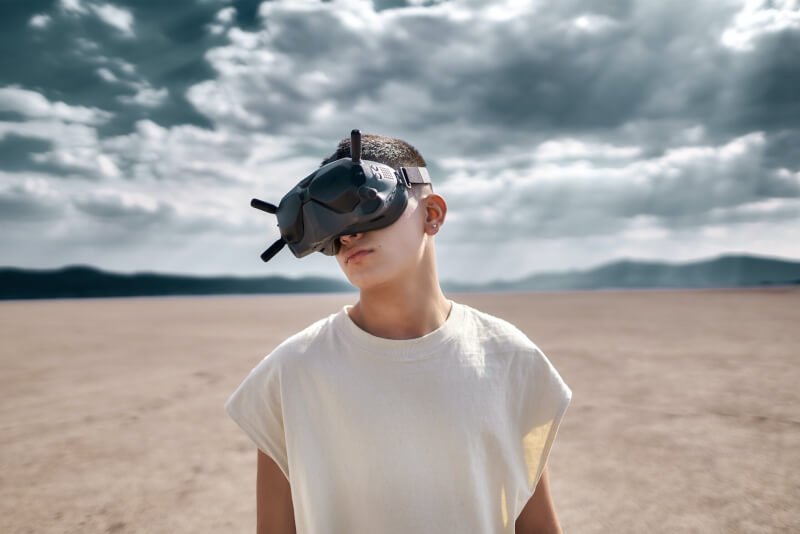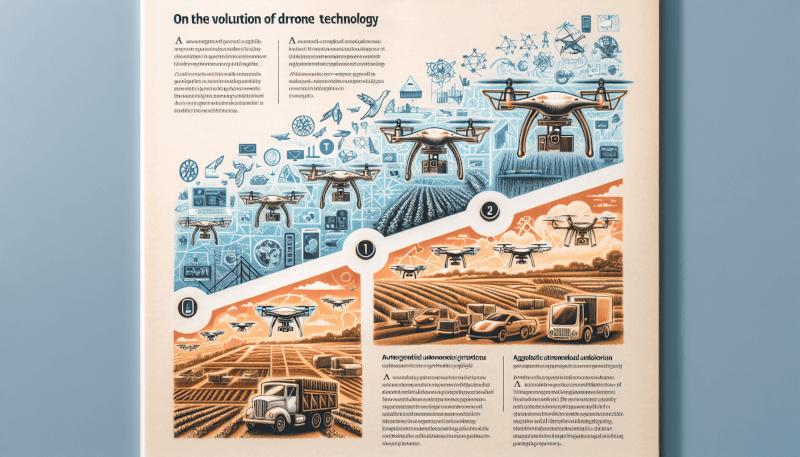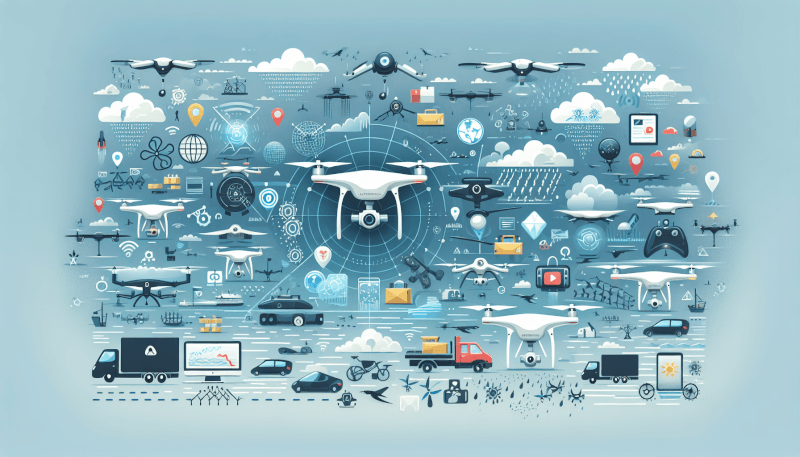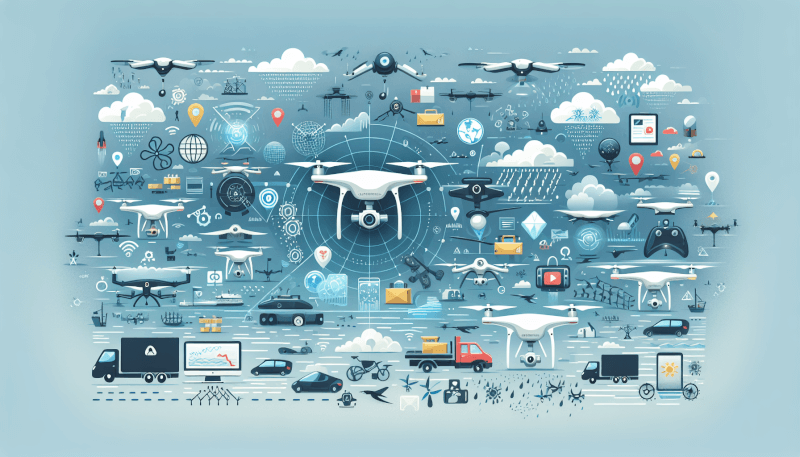Imagine a world where delivery drones whisk packages to your doorstep, where farmers use drones to monitor crops with precision, and where filmmakers capture stunning aerial shots effortlessly. The future of drone technology holds endless possibilities and advancements that will revolutionize various industries. From autonomous technologies to improved battery life, this article explores some of the exciting developments we can expect in the world of drones. So fasten your seat belts and get ready to soar into the future!

Increased Use of Drones for Commercial Purposes
Delivery services
With the advancement of drone technology, delivery services are being revolutionized. Drones are now being used by companies to deliver products and packages in a faster and more efficient way. They can navigate through crowded cities and avoid traffic, reaching their destinations in record time. This has the potential to greatly improve the efficiency of the delivery process and reduce costs for businesses. Imagine a world where you can order groceries or a new pair of shoes and have them delivered to your doorstep within minutes. Drones are making this a reality.
Aerial photography and cinematography
Drones have opened up new possibilities in the field of photography and cinematography. With their ability to capture high-quality images and videos from unique angles and heights, they have become an essential tool for professionals in these industries. Whether it’s capturing stunning landscape shots or filming action-packed scenes, drones provide an unprecedented level of creativity and versatility. They allow photographers and filmmakers to capture footage that was previously unattainable, giving their work a whole new dimension.
Agriculture and crop monitoring
The use of drones in agriculture has been steadily increasing, and it’s not hard to see why. Drones equipped with specialized sensors and cameras can provide farmers with valuable data about their crops, such as soil moisture levels, plant health, and pest infestations. This information allows farmers to make informed decisions about irrigation, fertilization, and pest control, ultimately leading to higher crop yields and reduced costs. Drones can cover large areas of farmland quickly and efficiently, making them an invaluable tool for the agriculture industry.
Advancements in Battery Technology
Improved flight time
One of the key limitations of drones has always been their flight time. Typically, drones could only stay airborne for a limited amount of time due to battery constraints. However, advancements in battery technology are changing this. New lithium-ion batteries with higher energy densities are being developed, allowing drones to stay in the air for longer periods. This increased flight time opens up new possibilities for drone applications, such as longer aerial surveys, extended surveillance missions, and extended delivery ranges. With longer flight times, drones can be more productive and efficient.
Faster recharging
Along with improved flight time, battery technology is also advancing in terms of recharging speed. In the past, recharging a drone’s battery could take hours, limiting its operational capabilities. However, rapid charging technologies are now being developed that can significantly reduce the charging time. This means that drones can be quickly recharged between missions, allowing for more frequent use and minimizing downtime. Faster recharging opens up new opportunities for businesses that rely on drones for their operations, as it enables increased productivity and responsiveness.

Autonomous and Artificial Intelligence
Advanced obstacle avoidance
One of the most exciting advancements in drone technology is the development of advanced obstacle avoidance systems. Drones can now be equipped with sensors, cameras, and artificial intelligence algorithms that enable them to detect and avoid obstacles in real-time. This technology ensures the safe and reliable operation of drones, especially in urban environments where there are many potential hazards. With advanced obstacle avoidance, drones can navigate complex environments autonomously, making them even more efficient and secure for various applications, from delivery services to search and rescue missions.
Smarter flight planning and navigation
Autonomous drones are not only capable of avoiding obstacles but also of planning their flight paths and navigating efficiently. With the integration of artificial intelligence, drones can analyze vast amounts of data, such as geographic information, weather conditions, and traffic patterns, to determine the most optimal routes. This results in faster and more efficient missions, whether it’s delivering packages, capturing aerial footage, or conducting inspections. Smarter flight planning and navigation also increase the reliability of drones, as they can adapt to changing conditions and avoid potential risks.
Automated inspections and surveillance
Another significant application of autonomous drones is in inspections and surveillance. By equipping drones with advanced sensors and cameras, they can autonomously inspect infrastructure, such as bridges, power lines, and pipelines, for signs of damage or wear. This eliminates the need for manual inspections, which can be time-consuming, costly, and sometimes dangerous. Drones can also be used for surveillance purposes, monitoring large areas or specific locations for security purposes. With their ability to fly autonomously, drones can provide constant surveillance without the need for human intervention, making them an invaluable asset in defense and security.
Integration with Internet of Things (IoT)
Drone data sharing and analytics
As drones collect vast amounts of data during their missions, their integration with the Internet of Things (IoT) allows for efficient data sharing and analytics. This means that the data collected by drones can be instantly transmitted and processed, providing real-time insights and actionable information. For example, in agriculture, drone-collected data on soil moisture levels and crop health can be shared with farmers’ IoT-enabled devices, allowing them to make timely decisions and take appropriate actions. This integration enhances the overall efficiency and effectiveness of drone operations, making them an essential part of the IoT ecosystem.
Smart home and city applications
Drones also have the potential to play a significant role in smart home and city applications. With their ability to navigate and collect data, they can be used for various purposes, such as monitoring home security, inspecting infrastructure, or delivering packages. Drones can be integrated with smart home systems, allowing users to remotely control and monitor their properties. In smart cities, drones can assist in traffic management, surveillance, and emergency response. The integration of drones with IoT technologies opens up endless possibilities for creating smarter, more efficient, and safer environments.

Enhancements in Sensor Technology
Improved image and video quality
Sensor technology plays a crucial role in the image and video quality captured by drones. As technology advances, sensors are becoming more sophisticated, resulting in higher resolution images and sharper videos. This is particularly important in applications such as aerial photography, cinematography, and inspections, where visual details are essential. Improved image and video quality not only enhance the overall aesthetics but also provide more accurate and detailed data for analysis and decision-making. With advancements in sensor technology, drones can capture breathtaking visuals with stunning clarity.
Sensors for environmental monitoring
Drones equipped with specialized sensors can contribute significantly to environmental monitoring and conservation efforts. The sensors can measure various parameters, including air quality, water quality, and vegetation health, providing valuable insights into the state of the environment. This data can aid in the detection of pollution sources, early identification of environmental risks, and assessment of ecosystem health. Drones can cover large areas quickly and collect data from otherwise inaccessible or hazardous locations. Their ability to monitor the environment from above offers a unique perspective and helps us better understand and protect our planet.
Regulatory Frameworks and Airspace Management
Drone traffic management systems
As the use of drones continues to increase, it becomes imperative to establish effective drone traffic management systems. These systems ensure the safe and efficient operation of drones, especially in shared airspace. They provide a framework for managing drone flights, scheduling missions, and monitoring air traffic. By implementing drone traffic management systems, we can prevent collisions between drones, other aircraft, and people on the ground. These systems will lay the foundation for the widespread integration of drones into our daily lives, ensuring a seamless and secure aerial infrastructure.
Airspace integration and regulations
The integration of drones into our airspace requires appropriate regulations and guidelines to ensure safety and compliance. Governments and aviation authorities have been working to establish regulatory frameworks for drone operations. These regulations address issues such as flight restrictions, pilot licensing requirements, and privacy concerns. Airspace integration and regulations also aim to balance the opportunities and benefits of drone technology with the need to protect public safety and security. As the technology continues to advance, the regulatory frameworks will evolve, ensuring responsible and accountable use of drones.

Defense and Security Applications
Surveillance and reconnaissance
Drones have become indispensable tools for defense and security agencies around the world. Their ability to fly covertly and collect real-time data makes them ideal for surveillance and reconnaissance missions. Drones equipped with high-resolution cameras and sensors can gather valuable intelligence, monitor critical infrastructure, and provide situational awareness. They can be deployed in various scenarios, from border surveillance to counter-terrorism operations. Drones greatly enhance the capabilities of defense and security forces, enabling them to respond more effectively to threats and protect their territories.
Border and coastal monitoring
The use of drones for border and coastal monitoring is becoming increasingly widespread. Drones can cover large areas, detect unauthorized border crossings, monitor ports and coastlines, and provide quick response in case of security breaches. They offer a cost-effective solution compared to traditional surveillance methods, such as manned aircraft or ground patrols. Drones equipped with thermal cameras and advanced imaging capabilities can detect and track suspicious activities, ensuring the safety and integrity of borders and coastal areas. They are a valuable asset in safeguarding national security and preventing illegal activities.
Emergency response and disaster management
Drones are playing a vital role in emergency response and disaster management situations. During natural disasters or humanitarian crises, drones can be quickly deployed to assess damage, search for survivors, and deliver essential supplies to inaccessible areas. Equipped with thermal cameras and other sensors, drones can locate people in need of assistance and provide real-time information to emergency response teams. They can also help in mapping affected areas and identifying potential hazards. Drones significantly improve the efficiency and effectiveness of emergency response efforts, saving lives and reducing the impact of disasters.
Urban Air Mobility and Passenger Drones
Flying taxis and public transportation
The concept of flying taxis and public transportation using drones is no longer a distant possibility but a promising reality. With advancements in technology, drones capable of carrying passengers are being developed and tested. These passenger drones, also known as flying taxis, can provide an alternative and efficient mode of transportation in heavily congested urban areas. By utilizing vertical takeoff and landing capabilities, passenger drones can navigate through crowded cities, bypassing traffic and reducing travel time. This futuristic mode of transportation promises to revolutionize urban mobility, providing a faster, greener, and more convenient way to get around.
Personal transportation and commuting
Beyond flying taxis, drones also have the potential to transform personal transportation and commuting. Personal-sized drones, capable of carrying individuals, can offer a new level of mobility and flexibility. Imagine avoiding rush hour traffic by simply hopping into your own drone and flying directly to your destination. Personal drones can navigate pre-determined routes or be controlled manually, giving users the freedom to choose their own path. While this technology is still in its early stages, the vision of personal flying vehicles is not far-fetched. In the future, we may see individuals commuting through the sky, bypassing traditional transportation constraints.

Medical and Healthcare Applications
Medical supply and organ transportation
One area where drones have the potential to make a significant impact is in medical supply and organ transportation. Drones can be used to deliver medical supplies, such as blood, vaccines, or emergency medications, to areas that are difficult to access or affected by natural disasters. Their ability to fly autonomously and navigate through challenging terrain makes them ideal for delivering life-saving resources quickly and efficiently. Additionally, drones can be utilized for organ transportation, ensuring timely and safe delivery of organs for transplant surgeries. By leveraging drone technology, medical professionals can enhance their response capabilities and save more lives.
Emergency medical services
Drones can also play a crucial role in emergency medical services. In emergency situations where time is critical, drones can quickly reach the scene and provide immediate assistance. Equipped with medical equipment, drones can deliver first aid supplies or automated external defibrillators, allowing bystanders or emergency responders to administer essential care before professional medical help arrives. Drones can also transmit live video feeds and vital signs data to medical professionals, enabling them to remotely assess the situation and provide guidance. This integration of drones into emergency medical services has the potential to improve patient outcomes and save more lives.
Drone Racing and Entertainment
Increased popularity of drone racing
Drone racing has gained significant popularity in recent years, emerging as an exciting and thrilling sport. Competitors pilot high-speed racing drones through challenging courses, showcasing their skills in precision and agility. With immersive first-person view (FPV) technology, viewers can experience the thrill of racing from the perspective of the drone itself. Drone racing is not only entertaining but also pushes the boundaries of drone technology, driving advancements in drone speed, maneuverability, and control. This fast-growing sport continues to captivate audiences worldwide, attracting both professional racers and enthusiastic hobbyists.
Virtual reality integration
The combination of drones and virtual reality (VR) technology is taking entertainment to new heights. By wearing VR headsets, users can immerse themselves in a virtual world and experience flying through the eyes of a drone. This integration allows for a truly unique and exhilarating experience, as users can explore breathtaking landscapes, perform daring maneuvers, and engage in virtual competitions. Virtual reality integration with drones opens up endless possibilities for entertainment, whether it’s through gaming, cinematic experiences, or interactive simulations. This exciting fusion of technologies offers a glimpse into the limitless entertainment potential of drones.
In conclusion, the future of drone technology is full of exciting possibilities. From delivery services and aerial photography to advancements in battery technology and autonomous capabilities, drones are transforming various industries. Integration with the Internet of Things, enhancements in sensor technology, and the development of regulatory frameworks are paving the way for responsible and efficient drone operations. Defense and security applications, urban air mobility, medical and healthcare applications, and the rise of drone racing and entertainment also demonstrate the diverse range of uses for drones in our future. As technology continues to evolve, we can expect even more innovative advancements in drone technology, further shaping our world and enhancing our lives. So get ready to look up, because the sky is the limit when it comes to the future of drone technology.


